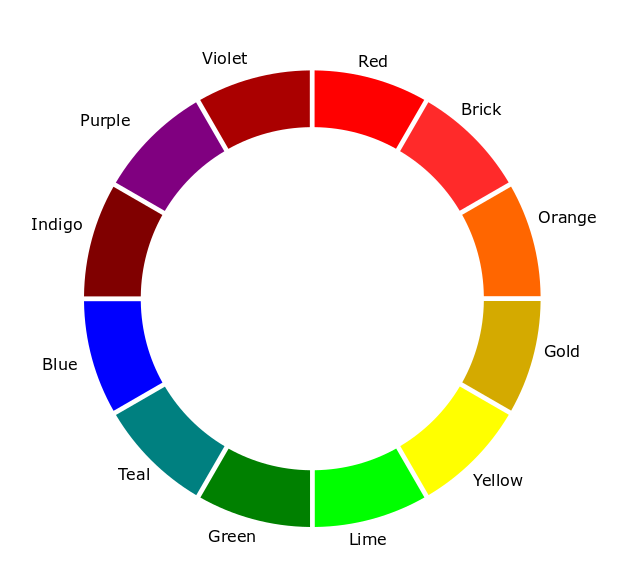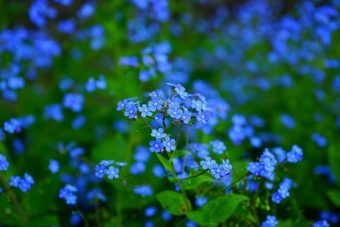In this series, we will be discussing the importance of getting the colour scheme in the container garden right. We will discuss plants that can be grown to suit each colour scheme. But before we do this, we have to talk about how the colour schemes are generated in the first place and the types of schemes that are possible. This is important if you want to get the balance right in your garden.

When you want to know what plant colours work well together in the garden, you need a methodology that makes matching colours easy to do. This is where the colour wheel comes into their own. This article is about how to use the colour wheel, which is sometimes known as the colour theme, is generated.
WHAT IS A COLOUR WHEEL?
A colour wheel is an artist’s tool that is used by gardeners and home decorators (for those who want to get their painting schemes and theme to complement or contrast each other)
It helps these people to pick colours that create a planting scheme that looks well organised and structured in some way.
This simple tool can prove an invaluable method of designing a whole container garden and to have a coherent look and feel to it.
The wheel is atypically made out of 12 colours, where each is divided into segments. The colour wheel is made up of 3 primary colours of red at the top, yellow at an angle of 120 degrees from the red, and blue which is another 120 degrees from the yellow. The colour wheel then contains 3 secondary colours of orange, green and purple, and 6 tertiary colours.
Colour schemes can be chosen from this colour wheel following basic colour theory guidelines.
THE PRIMARY, SECONDARY AND TERTIARY COLOURS
The three primary colours of red, yellow and blue are the base colours from which all other colours are made from. The primary colours cannot be made by mixing any other colour combinations together.

Secondary colours of orange, green and purple can be made by mixing two of the primary colours together. For example, mixing blue and yellow would result in a green colour.
The tertiary colours are made by mixing one primary colour with a secondary colour. For example, mixing primary colour blue with a secondary colour of green will produce a turquoise blue colour.
WARM COLOURS AND COOL COLOURS
Colours on the wheel can be divided into warm and cool colours. The warm colours liven up the area that they are grown in. The yellows, oranges and reds will brighten up any container garden. The colours and hues are noted for their dramatic effect on diverting your eyes away from the cool colours.
The most important feature of warm colours is that they make flowers look closer than they really are. This is why in garden design you place the warm colour at the front and the cool colours at the back.
v
The cool colours of blues and purples will quieten an area down. The colours are more restful and the area seems less oppressive on hot days. The colours will be overshadowed if they are planted amongst or next to bright warm coloured areas. The most important feature of cool colours is the way they make flowers look further away than they are really.
What is also important is how dark and light the colour is. Traditionally a colour that is normal or ‘pure’ that is neither too light nor too dark is known as a hue. A paler version of that hue is called a tint, whilst a darker version of the same hue is known as the shade.
Lighter versions of colours are collectively known as pastel colours, so, in fact, making warm colours look subdue. These pastel colours are made by adding white to the hue, whilst shades are made by adding black to the hue.
What must be considered when selecting your colour scheme is the appearance the weather has on the scheme. For example, pastel shades can look subdued in brilliant sunshine, whilst on dull days the colour will be highlighted.
FORGET THE DOS AND DONT’S
When you are selecting colours there are so many dos and don’ts with many purists will tell you that they must be rigidly stuck too. Do not put pink flowers next to orange or near dark crimson as it will clash, and so on. The rules are less important in the garden than it is made out to be.

The reason why colour rules do not have to be followed as rigidly is that a solid sheet of colour directly next to another solid sheet of colour of different hue for which it clearly does not harmonise can be horrid. In the garden, we do not have a solid wall of colours and that is why colour scheme rules do not have to be followed as rigidly. If you are into fashion or home decoration you will have to follow the rules more, if you do not want to make a faux pas.
The various hues, shades and tints in the garden can be broken up by the green leaves and other earthly colours which dilutes the colour clashes.
The best idea for you to do is read my forthcoming articles on colours scheme from warm colours, cool colours and pastel colours and which plant is suitable for each colour scheme. You have to use these articles with the colour wheel to fit your own personal likes and dislikes.
DO NOT FORGET THE NEUTRAL COLOURS
Neutral colours of blacks, whites and greys are important in colour scheme in your garden. White on its own has a calming effect and will stand out in cloudy days, At dusk, when the reds and purples fade out, white will stick out.
These are not the main reason why whites and grey are used, as they bring out the best in the other colours. Interest will be added to monochromatic and pastel schemes, where the garishness of over-bright contrasting schemes are reduced. Sometimes brown and beiges are used in exactly the same way to enhance colour and backgrounds.
TYPES OF COLOUR SCHEMES
To be sure that the colours in the garden do not clash with each other, there are three classical types of harmoniously colour schemes that can be used.
The MONOCHROMATIC scheme uses a single colour from the wheel, for example, green. When you are using a single colour planting scheme, you mix different shades, tints and hue intensities or you chose colours to maximise and enhance its effects.

The ANALOGOUS scheme or adjacent colour scheme uses two, three or four colours which are all neighbours in the wheel. For example, purple, pink and red can be used to give a beautiful scheme that produces a harmonious and pleasing mix.
The final scheme is called the COMPLIMENTARY or contrasting scheme, where colours directly opposite each other on the colour wheel is used. For example, blue will contrast with orange if used in the same scheme. When used together contrasting colours will enhance each other, so that a red flower such as a rose will stand out better against green leaves.
You now know how the colour wheel can be used to design your container garden so that colours can match and follow a scheme that will suit it.
CONCLUSIONS
In this article, we have discussed how the colour wheel can be used in order to select a coherent and beautiful colour scheme. You can see there are three schemes that gardeners can use for great effect from using one colours to using adjacent colours, or contrasting colours. Each colour scheme will add their own beauty to the container garden.
In the forthcoming posts, I will be discussing plants that can be used to give colour by using some of these mentioned schemes. Remember I can only suggest plants that can be used, it is up to you to choose your scheme and what plants to use within them. If you have a question or comment that you wish to make, please do so in the comment box below.
Happy colour selecting.

Now! This is one thing I am talking about. I really fancy this a lot and thank you for sharing here. If I can, I will definitely make proper attempt to following this. Often tines, we end up spoiling the way we present our decorations in the garden wrongly due to bad complimenting of colours of the flower and plants in the garden. This is a real time eye opener and enlightener. Thanks
This is a useful post. Especially now that I’m preparing my yard for new flowers, I haven’t thought of using a color wheel so far to choose the types of flowers I will plant, but it’s a great idea. I’ll apply some of your advice, and I’m sure this year I will have a yard that all my neighbors will envy 🙂
Hi Bluemoon
Thank you for those kind words and I wish you all the success for the forthcoming growing season. If you get the colours right your plants will look simply stunning. Look out for my future articles on plants for these schemes in the near future.
Kind regards
Antonio
Color brings out the beauty in anything but aside from beauty there are other functions of colors. The combination of the primary and secondary color to form the tertiary color can depend on the mode of color that is been used some green color can be light while others dark. But I am glad that most color rules don’t apply in the garden.
Hi Benny
You are right as you have more freedom in the garden but still the basic rules have to be followed, you do not want yo have horrid clashes with the plants you use or to blend into the background with obscurity. It is always good to follow the basic rules but you can be daring if you want to
Neutral colours are what makes or breaks scheme.
Thanks
Antonio
Wow. This is actually one article I can be grateful I didn’t pass by.
Truly, like you opined, worrying about colour clashes is one rule people like me don’t tend to obey when it comes to gardening. I really don’t apply too many dos and don’ts when it comes to picking colours for garden plants.
Among the colour schemes you listed, I like the complimentary scheme most, where colours directly opposite each other meet on the colour wheel. While gardening I rarely take out time to apply colour scheme rules. But this article has really taught me how to get plant colours in the right alignment.
Thanks for this informative post. It was really a great read. And I will take out time to check out forthcoming posts on this site.
Hi John
A lot of gardeners have an ad hoc approach to gardening and do not think about the colour scheme. If you get it totally wrong the colour will.look bland and uninspiring. This is why the colour wheel has been invented to help gardeners and home decorator to come with coherent designs.
Thank you for commenting and for your insight.
Antonio
Many thanks to you for sharing such an excellent article with us .I have a small garden and I plant a lot of flower trees here .A color wheel is an artist’s tool that I use for gardening and home decoration .This simple tool proved to be an invaluable way of designing a garden in a full container and I gained a consistent look and feel .I chose this color wheel from the color schemes following the basic color theory guidelines .When choosing the color scheme, I emphasized the presence of weather in the scheme .The red flowers have created a great color scheme and it looked very interesting to me .Each color scheme has added their own beauty to the container garden .Personally I like dos and don’ts trees .
Lastly, I hope that through your article everyone will know about this colorful wheel and will definitely share their new experiences with you. And I will definitely follow the tips you give .
Hi Shanta
Thank you for once again stopping by and commenting. Bringing colour to outdoor is very important as often people do not think about the clashes that colour can have. Weather also plays a part if it is sunny a garden will look different than if it is in the shade. All my tips in the article will help you to come up with a colour scheme that will suit you.
Kind regards
Antonio
Many thanks to you for giving us such a beautiful article about the Colour Wheel. I know home decorators and gardeners are using a color wheel. I think your article will greatly benefit me. Because I have a garden. and I think this color wheel will help me to select a coherent and beautiful color scheme. I am going to bookmark it. I think I will get marvelous outcomes from your specialty article. I must say that this article is very helpful and informative. Good Luck!
Hi sabrinamou
Colour schemes are so important as you want the garden to blend in with your surroundings or you may want to contrast with them, where reds and green will stick out more. You have to think of it as being a way of presenting home decor outside but with a smaller range of colours. You can have really colourful displays outside as well.
Kind regards
Antonio
First of all, thank you for sharing such a beautiful article with us. I learned a lot about Container Plants and Gardening by reading your articles. I have a garden Your article will help me to make the garden beautiful.
It’s really helpful for me. I will share your article with my friends.
I have enjoyed this post very much. I hope garden lovers will benefit from reading your post. They will surely share their opinion with you soon.
Thank you again for the nice post.
Hi Tashibaarzu
It is my pleasure in writing these articles to help people come up with beautiful designs that will help people improve their designs. Colour is one aspect that must be considered, otherwise you can get nasty clashes all over.Not a good luck. Stay tuned for my future articles on this topic.
Thank you for stopping by
Antonio
Hi there! Thank you very much for sharing this article. Your article had truly amazed me. I could know about balancing the beauty of garden by knowing about the colors.
Actually one of my uncle want to make a garden surrounding his house. I will share your article to him. He would really become very happy. I hope that after reading this article he would grow a good concept about gardening.
I want you to share more article like this.
Hi Fahim
Thank you for your kind words and hope your uncle gets as much information as possible. You need the colours on balance otherwise it can make your garden look unbalanced. In future articles I will talk about plants which can be used in these schemes, stay tune.
Kind regards
Antonio
Hello Antonio
I’ve learnt from your article that it is important to use color schemes correctly in gardening and in other aesthetic arts. The color wheel is of particular importance as it shows how colors are distributed relative to the primary ones- red, blue, and yellow. Neutral colors are of paramount importance too and cannot be ignored. What types of houseplants can be used for a lively blend of warm and neutral colored flowers?
Boniface
Hi Boniface
Thank you for commenting and asking that important question, which I will be answering in another article on colour scheme for houseplants. This will be published very soon and will have important information that you require.
Kind regards
Antonio